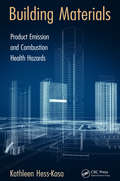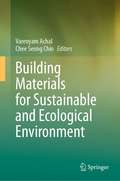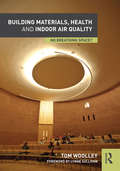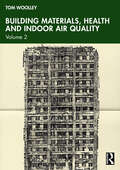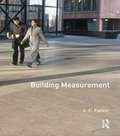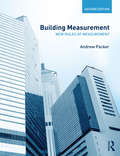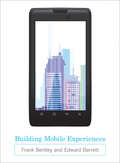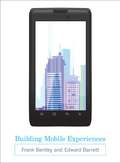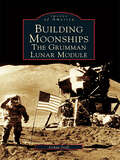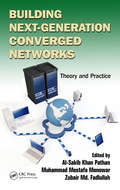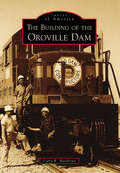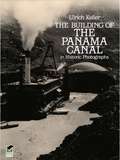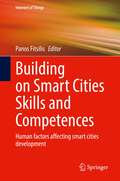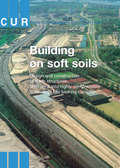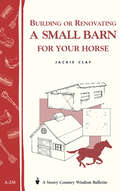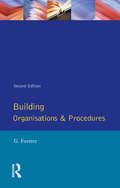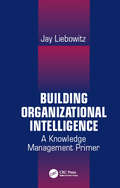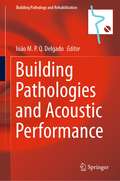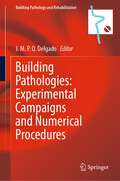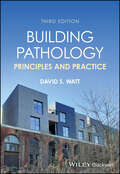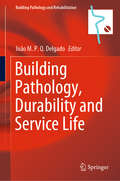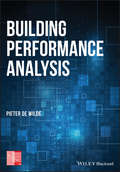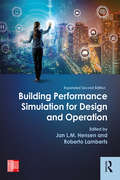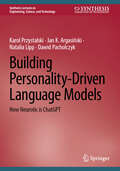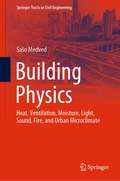- Table View
- List View
Building Materials: Product Emission and Combustion Health Hazards
by Kathleen Hess-KosaThe construction industry is bombarded with ever-changing building materials—components of which are more and more difficult, if not impossible, to identify. Building material emissions have been implicated as a major source of indoor air pollution, and toxic gases, often unidentified, are generated in building fires. Building Materials: Product Emission and Combustion Health Hazards undertakes the task of identifying building materials emission and combustion health hazards. This practical guide introduces the complex world of polymers commonly used in building materials along with plasticizers and additives that are not regulated by OSHA. It also explores the topic of building materials as they relate to function and their emissions/combustion products along with thermal decomposition and combustion products as they relate to fire first responders. Engaging environmental professionals, construction management firms, architects, first respondents, and students, this valuable reference delivers a comprehensive spectrum of knowledge needed to face the challenges of managing building materials in the twenty-first century. Awareness is the first line of defense!
Building Materials for Sustainable and Ecological Environment
by Varenyam Achal Chee Seong ChinThis book uses theories, hypotheses, policies, practical insights and case studies to introduce and elucidate green building materials for sustainable construction. Cement is the most widely used building material in construction; however, it is not sustainable, being responsible for 7% of global carbon dioxide emissions and consuming huge quantities of energy. In order to limit the ecological damage, sustainable building materials are needed. Ecosystems are a source of important lessons and models for transitioning the built environment onto a sustainable path that opens options for sustainable building material in construction. The book provides a guide for readers seeking knowledge on sustainable building materials with the potential to lower environmental impact by reducing CO2 emission throughout the building’s lifecycle. The book is motivated by recent rapid advances in sustainable building materials production, including green building materials made of industrial by-products and recycled wastes, earth materials, plant-based materials, microbial-based materials or supplementary cementitious materials, to reduce the environmental impacts of traditional building materials. Discussing the development and applications of various sustainable building materials, including related case studies, and addressing the environmental issue with a holistic and systematic approach that creates an ecology of construction for sustainability in infrastructures, it offers promising solutions to achieve renewable and sustainable building materials for the future.
Building Materials, Health and Indoor Air Quality: No Breathing Space?
by Tom WoolleyThe impact of building materials and construction methods on the health and wellbeing of occupants is often underestimated. This book is an essential guide to understanding and avoiding hazardous materials and poor air quality in buildings. The author covers a range of issues beginning with an explanation of how buildings work and how this influences the health of occupants and users. The text covers: Ventilation, air conditioning and indoor air quality Damp and mould Asthma and respiratory problems Cancer and endocrine disorders Radiation and radon Hazardous building materials used in construction Indoor air quality and emissions Ecological alternatives and approaches and remedies for ‘sick’ buildings The book also guides the reader through the confusing world of regulations, EU and international guidelines and certifications, and provides a critical analysis of different theories of healthy buildings and philosophies. Written in a clear and accessible style, this book provides indispensable advice and information to anyone wishing to better understand healthy buildings and materials. It is essential reading for architects, surveyors, public health professionals, facilities managers and environmentalists.
Building Materials, Health and Indoor Air Quality: Volume 2
by Tom WoolleyIn Building Materials, Health and Indoor Air Quality: Volume 2 Tom Woolley uses new research to continue to advocate for limiting the use of hazardous materials in construction and raise awareness of the links between pollutants found in building materials, poor indoor air quality and health problems. Chapters in this volume reinforce previous arguments and present new ones covering: Further evidence of the health impacts of hazardous emissions from materials Hazardous materials to be avoided and why Fire and smoke toxicity – the Lakanal House and Grenfell Tower legacy Sub-standard retrofits leading to damp and mould in previously sound houses A critical review of recent reports from UK Government and others on air quality and health problems including policy changes on flame retardants Growing evidence of cancer risks and the failure of cancer research organisations to address these issues A critical review of recent climate change and zero carbon policies and a discussion on whether extreme energy efficiency is a good thing This book asks some important and, for some, uncomfortable questions, but in doing so it brings to light important areas for research and provides much needed guidance for architects, engineers, construction professionals, students and researchers on hazardous materials and how to reduce their use and design and build healthier buildings for all occupants.
Building Measurement
by Andrew D. PackerBuilding Measurement provides a practical guide to the purpose and techniques of construction measurement, based on the current edition of the standard of measurement, SMM7. The introductory section identifies established practices in measurement, including booking dimensions and documents production, and provides an overview of the new technologies associated with computer-based methods.The book examines the principles of measurement and applies these techniques to a range of trades including substructures, external walls, structural floors, flat and pitched roofs, roof coverings, finishes, standard joinery, electrical/mechanical services and drainage installations.
Building Measurement: New Rules of Measurement
by Andrew D. PackerMeasurement of buildings is the core skill of the quantity surveyor. It underpins the procurement, management, delivery and subsequent commissioning of a completed building, and must now be completed using New Rules of Measurement 2 (NRM 2). In this much-needed new measurement textbook, the measurement of the most common building elements is described using NRM2. Extensive worked examples including fully up to date hand-drawn diagrams and supporting take-off lists ensure that the reader develops a confidence in their ability to measure using NRM2 in practice. A practical step-by-step approach is used to explain and interpret the detail of the specific Work Sections of NRM2, covering a broad range of different trades, including mechanical and electrical systems; external works; groundwork; masonry; joinery; and internal finishes. Presuming no prior knowledge of measurement or NRM2, and fully up to date with current practice, including consideration of Building Information Modelling, this is the ideal text for students of measurement at HND or BSc level, as well as practitioners needing a crash course in how to apply NRM2.
Building Mobile Experiences (The\mit Press Ser.)
by Frank Bentley Edward BarrettMethods for new mobile experiences, from concept creation to prototyping to commercialization.The mobile device is changing the ways we interact with each other and with the world. The mobile experience is distinct from the desktop or laptop experience; mobile apps require a significantly different design philosophy as well as design methods that reflect the unique experience of computing in the world. This book presents an approach to designing mobile media that takes advantage of the Internet-connected, context-aware, and media-sharing capabilities of mobile devices. It introduces tools that can be used at every stage of building a mobile application, from concept creation to commercialization, as well as real-world examples from industry and academia.The methods outlined apply user-centered design processes to mobile devices in a way that makes these methods relevant to the mobile experience—which involves the use of systems in the complex spatial and social world rather than at a desk. The book shows how each project begins with generative research into the practices and desires of a diverse set of potential users, which grounds research and design in the real world. It then describes methods for rapid prototyping, usability evaluation, field testing, and scaling up solutions in order to bring a product to market. Building Mobile Experiences grew out of an MIT course in communicating with mobile technology; it is appropriate for classroom use and as a reference for mobile app designers.
Building Mobile Experiences
by Frank Bentley Edward BarrettThe mobile device is changing the ways we interact with each other and with the world. The mobile experience is distinct from the desktop or laptop experience; mobile apps require a significantly different design philosophy as well as design methods that reflect the unique experience of computing in the world. This book presents an approach to designing mobile media that takes advantage of the Internet-connected, context-aware, and media-sharing capabilities of mobile devices. It introduces tools that can be used at every stage of building a mobile application, from concept creation to commercialization, as well as real-world examples from industry and academia. The methods outlined apply user-centered design processes to mobile devices in a way that makes these methods relevant to the mobile experience--which involves the use of systems in the complex spatial and social world rather than at a desk. The book shows how each project begins with generative research into the practices and desires of a diverse set of potential users, which grounds research and design in the real world. It then describes methods for rapid prototyping, usability evaluation, field testing, and scaling up solutions in order to bring a product to market. Building Mobile Experiences grew out of an MIT course in communicating with mobile technology; it is appropriate for classroom use and as a reference for mobile app designers.
Building Moonships: The Grumman Lunar Module (Images of America)
by Joshua StoffIn 1961, after the United States had acquired a total of fifteen minutes of spaceflight experience, President John F. Kennedy announced his plans for landing a man on the moon by 1970. The space race had begun. In 1962, after a strenuous competition, the National Aeronautics and Space Administration (NASA) announced that the Grumman Aircraft Engineering Corporation of Bethpage, Long Island, had won the contract to build the lunar module-the spacecraft that would take Americans to the moon. This was the first, and the only, vehicle designed to take humans from one world to another.Although much has been written about the first men to set foot on the moon, those first hesitant steps would not have been possible without the efforts of the designers and technicians assigned to Project Apollo. Building Moonships: The Grumman Lunar Module tells the story of the people who built and tested the lunar modules that were deployed on missions as well as the modules that never saw the light of day. This is the first publication to chronicle the visual history of the design, construction, and launch of the lunar module-one of the most historic machines in all of human history.
Building Next-Generation Converged Networks: Theory and Practice
by Zubair Md. Fadlullah Al-Sakib Khan Pathan Muhammad Mostafa MonowarSupplying a comprehensive introduction to next-generation networks, Building Next-Generation Converged Networks: Theory and Practice strikes a balance between how and why things work and how to make them work. It compiles recent advancements along with basic issues from the wide range of fields related to next generation networks. Containing the co
Building of the Oroville Dam, The
by Larry R. MatthewsIn the early 1960s, thousands of construction workers and their families came to Oroville, in Northern California, to help build the largest earth-fill dam in the world. Located nine miles northeast of town, the Oroville Dam would be the cornerstone of the California State Water Project, which would provide flood control, electric power, recreation, and water to California residents. The project was so massive that it would reinvent the look of much of the area; require the building of roads, bridges, and railroads; inundate much of the area's history under hundreds of feet of water; and greatly effect the lives of the residents of Oroville. The successful completion of the project came at a price--34 construction workers died.
The Building of the Panama Canal in Historic Photographs
by Ulrich KellerIn 1889 the Compagnie Universelle du Canal Interocéanique declared bankruptcy. The French firm's optimistic and ill-planned attempt to construct a canal across the Isthmus of Panama had resulted in the death of 22,000 workers (most from yellow fever, typhoid fever, and malaria); the complete loss of one and a half billion francs for the company's 800,000 shareholders; and the bitter failure of Chief Engineer Ferdinand de Lesseps -- the man responsible for the Suez Canal. On August 15, 1914, the S.S. Ancon took nine hours and forty minutes to traverse the lock-and-lake waterway linking the Atlantic and Pacific Oceans. What occurred in the quarter century between 1889 and 1914 is a larger-than-life true story of adventure, revolution, ordeal, and accomplishment: the building of the Panama Canal -- perhaps the greatest engineering marvel of the early twentieth century.In 164 magnificent historic photographs and a well-researched text, noted photohistorian Ulrich Keller tells the compelling story of this hitherto unparalleled technological achievement. Selected from an archive of over 10,000 images amassed by Ernest Hallen (Official Photographer of the Isthmian Canal Commission), these historic prints document the Canal's construction and its way of life: 450 miles of railroad; housing for 60,000 based on a caste system; the exotic settings; tremendous hardships and health risks; leisure activities; the Canal Zone's internal government, administration and policing; dredging operations, including spectacular movements of earth and water; unheard-of engineering feats and disastrous failures; and finally, victory!Photographers, historians, engineers, and tudents of industry and technology will immediately recognize this volume as an important primary source of industrial archaeology. Photography enthusiasts and lovers of true adventure will delight in the vibrant, you-are-there sensation imparted by the photos and Ulrich Keller's exceptionally informed text and meticulous captions. The Building of the Panama Canal in Historic Photographs takes the reader back to a different era, and one of the proudest episodes in what the author calls "the 'heroic' age of industry."
Building on Smart Cities Skills and Competences: Human factors affecting smart cities development (Internet of Things)
by Panos FitsilisThis book provides insights on skills required to achieve success in smart cities from a variety of industry and human factors perspectives. It emphasizes the balance between learning skills, technical skills, and domain-specific skills in these industries, with special emphasis given to innovative software development models. The authors note that digital transformation requires complementary measures that are not overtly aimed to support infrastructure investment but are instead directed at promoting entrepreneurship, improving digital skills, engaging citizens, applying new transformation strategies, and developing innovative software. All of the above are considered strategically important, especially for medium-sized cities since that enable them to be more competitive in the global economy.
Building on Soft Soils
by CURCentreforCivilEngineeringA comprehensive practical manual covering all aspects of this field, this book covers everything from the pre-design stage up to, and including, the actual use (including maintenance) of the completed structures. Much attention is given to the calculation methods available for design and construction, including establishing the soil parameters required, with emphasis placed on probabilistic safety analysis. This informative book includes an inventory of:· the properties of natural types of soil, secondary materials, and light-weight materials· raising and filling construction methods· techniques and methods to speed up consolidation and limit deformation Compiled by researchers from Fugro, Delft Geotechnics and several other Dutch contractors, it includes useful appendices focusing on particular points of interest from the preceding chapters.
Building or Renovating a Small Barn for Your Horse: Storey Country Wisdom Bulletin A-238 (Country Wisdom Bulletin Ser. #Vol. A-238)
by Jackie ClaySince 1973, Storey's Country Wisdom Bulletins have offered practical, hands-on instructions designed to help readers master dozens of country living skills quickly and easily. <P><P>There are now more than 170 titles in this series, and their remarkable popularity reflects the common desire of country and city dwellers alike to cultivate personal independence in everyday life.
Building Organisation and Procedures (Longman Technician Series)
by George ForsterTopics discussed include the structure and magnitude of the construction industry, responsibilities and roles of the organisations and people within the industry.
Building Organizational Intelligence: A Knowledge Management Primer
by Jay Liebowitz"Sharing knowledge is power." If ever there were a field to which this applies, it is the knowledge management industry. And in today's highly-competitive, fast-paced business world, corporations, businesses and organizations in both the public and private sectors are constantly searching for new cutting-edge methods and techniques for creating, storing, capturing, managing, organizing, distributing, combining, and retrieving knowledge. But the task of accomplishing such functions is not as simple as it sounds. Jay Liebowitz's Building Organizational Intelligence: A Knowledge Management Primer gives executives, managers, systems analysts, and other knowledge-management professionals the competitive edge they need in achieving that task. In a concise and easy-to-read format, the book describes the concepts, techniques, methodologies, and tools associated with those functions, and includes mini-case studies and vignettes of how industry is developing and applying these functions towards building organizational intelligence.What's more, the book is packaged with a limited functionality version of "WisdomBuilder," the first in a family of knowledge-management tools that provide a fully integrated solution to the information management and analysis dilemma. Able to run under Windows 95, 98 and NT, "WisdomBuilder" solves the information overload problem by reducing the time and cost of extracting information and other research knowledge from disorganized repositories of heterogeneous data.
Building Pathologies and Acoustic Performance (Building Pathology and Rehabilitation #18)
by João M. P. Q. DelgadoThis book presents recent research works related to salt attack and corrosion in concrete structures, durability and service life in concrete, non-destructive techniques applied to reinforced concrete structures and acoustic performance of buildings. It identifies anomalies that affect the acoustic performance and the concrete structures, namely anomalies associated to salt attack and corrosion that affects the durability and service life of the buildings, in order to be eliminated in future projects. Offering a systematic review of the current state of knowledge, the book serves as a valuable resource for scientists, students, practitioners, and lecturers in various scientific and engineering disciplines, including civil and materials engineering, as well as and other interested parties.
Building Pathologies: Experimental Campaigns and Numerical Procedures (Building Pathology and Rehabilitation #25)
by J. M. P. Q. DelgadoThis book provides a collection of recent research works related to building pathologies, in order to contribute to the systematization and dissemination of knowledge related to construction pathology, hygrothermal behavior of buildings, durability and diagnostic techniques and, simultaneously, show the most recent advances in this domain. It is divided into six chapters that intend to be a resume of the current state of knowledge for benefit of professional colleagues, scientists, students, practitioners, lecturers, and other interested parties to network. At the same time, this book encounters a variety of scientific and engineering disciplines, such as civil, mechanical, and materials engineering.
Building Pathology: Principles and Practice
by David S. WattWell-illustrated introduction to building pathology, bridging the gap between building surveying and the detailed understanding of building defects, their prognosis and remediation Building Pathology introduces the concept of building pathology and aims to give the reader a greater awareness and understanding of buildings and their users, to assist in defect diagnosis and the design and implementation of specific and appropriate remedial measures. By focusing on the process, rather than specific solutions, the book helps the reader to use the information in their practice in a wide variety of situations. The new third edition features new case studies which have been integrated into the text. Written by a highly qualified author with significant experience in the field, the third edition of Building Pathology contains information on: Building performance, covering environmental factors, user requirements, building structures and materialsDefects, damage, and decay, covering atmospheric and climatic action, excess moisture, chemical, physical, and biological action, movement, fire and human factorsSurvey and assessment, covering building inspections and surveys, how to prioritize defects, unoccupied buildings and sites, and redundant and ruined buildingsRemediation in practice, covering real-world examples With comprehensive coverage of the subject, Building Pathology is an essential learning resource for students of building surveying, as well as professional architects, building surveyors, property managers and those working in heritage disciplines.
Building Pathology, Durability and Service Life (Building Pathology and Rehabilitation #12)
by J. M. P. Q. DelgadoThis book provides a collection of recent research works, helping contribute to the systematization and dissemination of the latest findings on building pathologies (structural and hygrothermal), salt attack and corrosion, durability and service-life prediction. It reflects a number of recent advances concerning the above-mentioned topics, particularly in concrete structures. Intended as an overview of the current state of knowledge, the book will benefit scientists, students, practitioners, lecturers and other interested parties. At the same time, the topics covered are relevant to a variety of scientific and engineering disciplines, including civil, materials and mechanical engineering.
Building Performance Analysis
by Pieter De WildeExplores and brings together the existent body of knowledge on building performance analysis Building performance is an important yet surprisingly complex concept. This book presents a comprehensive and systematic overview of the subject. It provides a working definition of building performance, and an in-depth discussion of the role building performance plays throughout the building life cycle. The book also explores the perspectives of various stakeholders, the functions of buildings, performance requirements, performance quantification (both predicted and measured), criteria for success, and the challenges of using performance analysis in practice. Building Performance Analysis starts by introducing the subject of building performance: its key terms, definitions, history, and challenges. It then develops a theoretical foundation for the subject, explores the complexity of performance assessment, and the way that performance analysis impacts on actual buildings. In doing so, it attempts to answer the following questions: What is building performance? How can building performance be measured and analyzed? How does the analysis of building performance guide the improvement of buildings? And what can the building domain learn from the way performance is handled in other disciplines? Assembles the current body of knowledge on building performance analysis in one unique resource Offers deep insights into the complexity of using building performance analysis throughout the entire building life cycle, including design, operation and management Contributes an emergent theory of building performance and its analysis Building Performance Analysis will appeal to the building science community, both from industry and academia. It specifically targets advanced students in architectural engineering, building services design, building performance simulation and similar fields who hold an interest in ensuring that buildings meet the needs of their stakeholders.
Building Performance Simulation for Design and Operation
by Jan L.M. Hensen Roberto LambertsWhen used appropriately building performance simulation has the potential to reduce the environmental impact of the built environment, to improve indoor quality and productivity, as well as facilitating future innovation and technological progress in construction. Since publication of the first edition of Building Performance Simulation for Design and Operation, the discussion has shifted from a focus on software features to a new agenda, which centres on the effectiveness of building performance simulation in building life cycle processes. This new edition provides a unique and comprehensive overview of building performance simulation for the complete building life-cycle from conception to demolition, and from a single building to district level. It contains new chapters on building information modelling, occupant behaviour modelling, urban physics modelling, urban building energy modelling, and renewable energy systems modelling. This new edition keeps the same chapter structure throughout including learning objectives, chapter summaries and assignments. Moreover, the book: • Provides unique insights into the techniques of building performance modelling and simulation and their application to performance based design and operation of buildings and the systems which service them. • Provides readers with the essential concepts of computational support of performance based design and operation. • Provides examples of how to use building simulation techniques for practical design, management and operation, their limitations and future direction. It is primarily intended for building and systems designers and operators, post-graduate architectural, environmental or mechanical engineering students
Building Personality-Driven Language Models: How Neurotic is ChatGPT (Synthesis Lectures on Engineering, Science, and Technology)
by Karol Przystalski Jan K. Argasiński Natalia Lipp Dawid PacholczykThis book provides an innovative exploration into the realm of artificial intelligence (AI) by developing personalities for large language models (LLMs) using psychological principles. Aimed at making AI interactions feel more human-like, the book guides you through the process of applying psychological assessments to AIs, enabling them to exhibit traits such as extraversion, openness, and emotional stability. Perfect for developers, researchers, and entrepreneurs, this work merges psychology, philosophy, business, and cutting-edge computing to enhance how AIs understand and engage with humans across various industries like gaming and healthcare. The book not only unpacks the theoretical aspects of these advancements but also equips you with practical coding exercises and Python code examples, helping you create AI systems that are both innovative and relatable. Whether you’re looking to deepen your understanding of AI personalities or integrate them into commercial applications, this book offers the tools and insights needed to pioneer this exciting frontier.
Building Physics: Heat, Ventilation, Moisture, Light, Sound, Fire, and Urban Microclimate (Springer Tracts in Civil Engineering)
by Sašo MedvedThe book presents the theoretical background of building physics, dealing with the evaluation of physical phenomena related to heat transfer and energy use in buildings, water and water vapour transfer in building structures, daylighting and electric lighting of buildings, sound transmission in building structures and protection against noise, the occurrence and spread of fires in buildings and the thermal response of cities. It contains numerical and computational evaluation methods, numerous computational case studies and examples of experimental analyses. The book demonstrates that the considered physical processes affect the quality of living and working comfort in indoor and outdoor environment.
